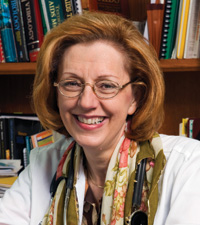Outwitting HIV/AIDS
Margaret Fischl leads fight to vanquish killer virus
 |
| Margaret Fischl, M.D. ’76, one of the world’s leading HIV/AIDS physician-scientists, is seeking ways to block the virus’s ability to incorporate its genetic coding into cellular DNA. |
A thicket of documents totally obscures the desk of Margaret Fischl, M.D. ’76, director of the AIDS Clinical Research Unit and world-renowned HIV/AIDS authority. She’s just helped the Miller School apply for a Clinical and Translational Science Award, hence the paperwork avalanche inside her Elliott Building office.
“This is not normal,” says Fischl, a tall, intense woman who smiles slightly as she gestures at the ubiquitous stacks of paper. What is normal, though, is the unwavering focus Fischl has brought to the battle against HIV/AIDS for more than a quarter century. These days Fischl has a new weapon at her disposal, and she grows animated when talking about it.
“We’re really excited about our HIV vaccine trials,” Fischl says. “The ability of this University to enter another phase of HIV research is really incredible. And it’s the final frontier—if it gets out there and does really well, it’s going to be a big, big breakthrough.”
Fischl played a major role in pioneering the use of azidothimidine (AZT) to treat HIV/AIDS patients. AZT was the first treatment that slowed the course of the disease. Her role in this breakthrough earned her a derisive ‘Queen of AZT’ moniker in the early 1980s from activists who also accused the government of trying to kill gays. At the time, Fischl and other leaders in HIV/AIDS research were burned in effigy. She has attended at least one scientific conference with a bodyguard in tow.
Those who questioned and opposed her research never altered Fischl’s outspoken advocacy on behalf of HIV/AIDS sufferers, nor the passion and vigor with which she pursues her life’s work. Fischl starts seeing HIV/AIDS patients at 6 a.m. and typically doesn’t leave her clinic until 6 or 7 p.m.
After AZT was introduced, the HIV virus rapidly developed a resistance to the drug. Fischl played a key role in the development of double and triple combination therapy, leading to the control of HIV.
A significant roadblock to completely conquering HIV is the virus’s ability to segue into dormant mode, giving the erroneous impression it’s been vanquished. It’s a trait that has allowed the virus to cruise under the radar of anti-viral drugs designed to seek out active viruses. However, a solution may lie with a new class of antiretroviral drugs known as integrase inhibitors, especially when combined with other agents, such as a vaccine.
Integrase inhibitors are a major reason why Fischl is so enthusiastic about her HIV vaccine trials, slated to get under way this year.
“The HIV/AIDS virus incorporates its genetic coding into the host DNA, and then the cell goes into a resting stage,” Fischl carefully explains. “Therefore all the drugs you’re giving are not touching that cell. We can knock out all measurable HIV, but it’s still in this resting cell, in a quiescent, latent phase. And if you wake up that cell, there comes the virus right back—explosively. So if you stop treatment, within days you can see the virus come back from this latent reservoir.
“Integrase inhibitors inhibit the integration of the HIV virus into a cell, and that’s turning out to be a critical step in how this virus attacks the immune system,” Fischl continues. “Combined with other therapy approaches, such as vaccines, integrase inhibitors may enable us to affect resting, quiescent viruses that establish latent infection. Our inability to do that thus far is why we can’t cure HIV.”
After earning her M.D. from the University of Miami in 1976, Fischl was doing a residency in internal medicine at University of Miami/Jackson when a mysterious disease began causing young men to disintegrate before her eyes.
That’s how Fischl became immersed in the world of HIV/AIDS. Some have characterized her indoctrination as serendipitous, and Fischl agrees—up to a point.
“Yes, some of it was being there at the right time,” she allows. “But it was also seeing HIV/AIDS for what it was and really going after it to work toward treatment and a cure. Because without a long-term objective, you’re just going to write one paper, not solve the problem.”
Today Fischl is recognized worldwide as one of the key figures in the HIV/AIDS research establishment. Her notoriety allowed her to lure Sophia Loren to South Florida to raise money for AIDS research in 1989.
“I love what I do,” Fischl says, putting into words what her high-energy demeanor and the gleam in her eyes have already made clear. “I love working in this field. I love working with my colleagues. I love getting answers, slowly but surely, and really making a difference.
“In all honesty, when we were first starting this, I never thought that we’d be where we are today,” Fischl marvels. “When HIV/AIDS first broke, I would tell myself: ‘We’re going to cure this.’ But you were not necessarily so bold as to really say that.
“Now I’m not afraid to say it: We will cure this.”
|


